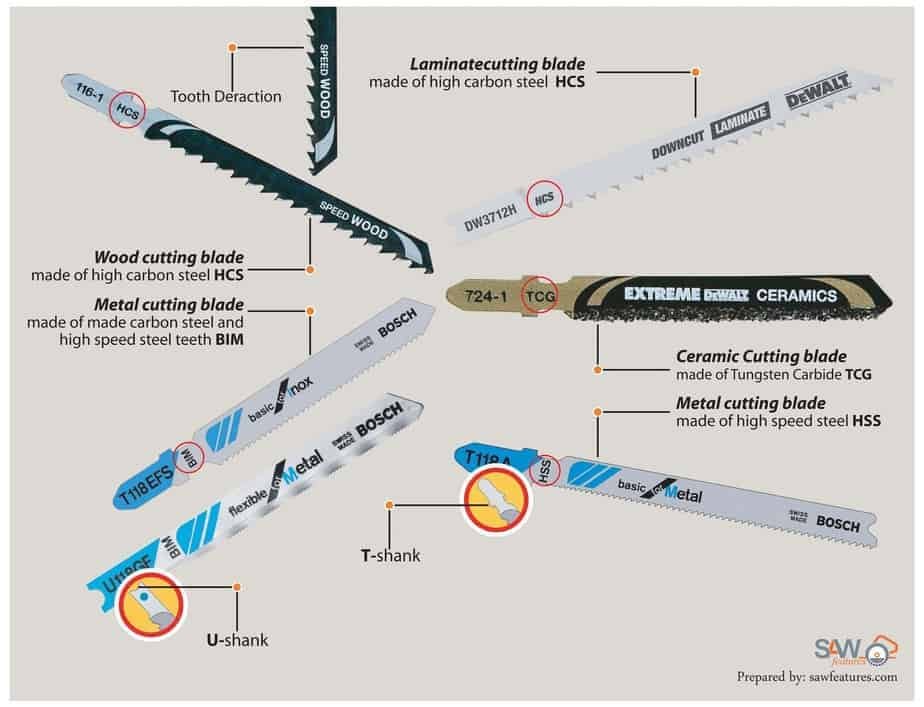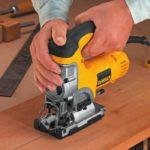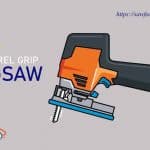Whether you are a contractor, professional woodworker, or a homeowner has a various cutting task such as timber, metal, plastic, and you must identify the anatomy of a jigsaw blade. There are a number of jigsaw blades types which adapt the tool for a wide of different cutting task.
You are here, so we guess that you are on the lookout of a perfect jigsaw blade. This post will surely provide you with some valuable information on how to buy the choicest one for your next project.
In the last couple of weeks, we investigate about jigsaw blades types and try to find out every segment of a jigsaw blade. Because it is important to choose the right blade for the good performance of Corded Jigsaws.
As a following, We found the shank type, blade length, toothed, and material there four primary components have a jigsaw blade. The cutting performance will depend on these factors.
Many elements are inside the primary components. However, we identified few factors for classified the edges; there are Teeth per inch TPI, Teeth Detraction, The shape, Teeth Layouts, Milled teeth, Ground teeth, and arrangement.
This outline, with bullets, points below explicit your concept of a jigsaw blade and a lot more to make it easier for you to buy a perfect jigsaw blade.
So, let us begin!
Jigsaw blades types: You should Consider when buy a Jigsaw Blades
we present the at a glance for you to understand quickly what's the metricks consider when buy a Jigsaw blades.
- Toothed
- Teeth per inch TPI
- Teeth Detraction
- The shape and arrangement
- Milled teeth
- Ground teeth
- Material / Fabrication
- High carbon steel HCS
- High-speed steel HSS
- Tungsten carbide
- Bi-metal
- Sank type
- T-sank
- U-sank
- Blade length
Jigsaw blade: How do you choose the right one?
You require learning the few fundamental factors to choose the right one. Different materials, Different type of cuts, require different jigsaw blades. Thus, before you pick a jigsaw cutting edge. Determine first what kind of material you need to cut (wood, plastics, metal, laminate, fiberglass, non-ferrous metals, steel, or ceramic? Next look at what type of cuts you need fine, fast, tight cuts, rough cuts, Clean, scrolling or a combination.
After deciding on the above to consider the most common and most flexible are the toothed, number of blade teeth per inch (TPI), square or straight, milled or ground, in various lengths. Most woodcutting blades have 21 teeth per inch, and metal cutting blades have 36 TPI or higher.
Moreover, make sure what type of blade is compatible with your jigsaw. There are three major types of jigsaw blade shank are in the market. Some jigsaw accepts T-shank blades while others accept U-shank blades. Some will accept either type of blade.
Blade alignment is another important component. Some manufacturers offer disposable plastic guides to hold the blade in alignment with the base. Other manufacturers offer solid metal guides.
From my experience, the metal blades offer more reliable blade alignment.
Hopefully, Considering these factors, we discuss in the paragraph will help you get the right jigsaw blade for your Cutting task.
Choose the Right Blade for Wood
Most novice DIY make a common mistake. They are not using the best Jigsaw blades for wood cutting task. It’s challenging to pick the proper blade for a novice DIY because they have no enough information of blades widths, lengths and tooth configurations. Remember the two significant facts of a jigsaw blades for woodworking. First, more long blades are best for making long and straight cuts, and narrow for curves cutting.

High Carbon Steel (HCS) Blades
Second, large blade with fewer teeth quick performance However, produces a rough, fragmented surface with smaller teeth but more of cut slower but leave behind a smoother surface. Check the specific information on the type and thickness of material designed to cut when purchasing a new blade.
Most woodworkers are the desire for High carbon steel (HSC) blades in woodworking operations.
Choose the Right Blade for Metal
Just consider few matrixes It’s effortless to find the correct metals cutting blade. We suggest you review the ensuing rules When choosing a jigsaw blades for metal cutting task. What Type of material are you cutting? However, Selecting a blade depends on the thickness of the metal being cut. Remember first, Blades for cutting through metal demand higher (TPI) than wood-cutting blades.
However, metal-cutting jigsaw blades typically have 21 to 24 teeth per inch (TPI). Also, they require a more flexible to promote heat dissipation. Experts are desire 36 TPI for very smooth Cut. After considering jigsaw blade toothing, choose blade metal the High-speed steel blade (HSS), and Bi-metal blades are ideal for metal cutting task.

High-Speed Steel (HSS) Blades
Choose the Right Blade for ceramic and tile
In these particulars, Toothless tungsten carbide sharp edges which can pierce, with no trouble, tiles, and ceramic. Apply water to lubricate the saw cut for thin flooring. Thicker tile requires greasing up the saw cut with cutting oil.
For glass, the task is fragile; however, in case you’re left with no other alternative, uncommon glass cutting oil is available, although it is smarter to complete a trial first. To cut through hardwood, metal, or plastic you can use a high speed steel blade. Bi-metal blades are perfect for heavy duty wood and metal cutting applications as well as laminate flooring. And tungsten carbide blades are used for cutting tiles and steel.

The bottom line
When you need to buy a new one, there are a number of questions that should be answered to make sure that the blade you choose is perfect for your cutting task.
Remember Your money and time entirely west if you are not to single out the right blade for the relevant cutting task. However, a profectional jigsaw performance as better than its blade,
Hopefully, I guess you understand the significance of a jigsaw blade.






It’s interesting to know that it is the teeth per inch that I should look at when choosing saws based on the material that I cut. I’ve been wanting to have heavy duty saw blades for cutting stainless steel for a while now. Perhaps I should start by looking for 36 TPI saws at the minimum.
What is the best blade to buy right now in 2021 in Makita Jigsaw? Because I am having trouble in the selected jigsaw blade.